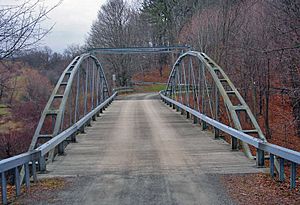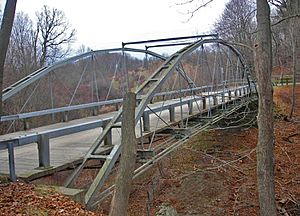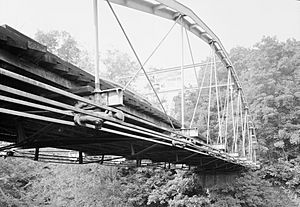Whipple Cast and Wrought Iron Bowstring Truss Bridge facts for kids
Quick facts for kids Whipple Cast and Wrought IronBowstring Truss Bridge |
|
|---|---|

Bridge seen from west, 2006
|
|
| Coordinates | 42°38′09″N 73°48′02″W / 42.63583°N 73.80056°W |
| Carries | Mill Road |
| Crosses | Unnamed tributary of Normans Kill |
| Locale | Albany, NY, U.S. |
| Other name(s) | Normanskill Farm Bridge |
| Owner | City of Albany |
| Heritage status | NRHP #71000523 |
| Characteristics | |
| Design | Whipple bowstring truss bridge |
| Material | Iron |
| Total length | 109.9 feet (33.5 m) |
| Width | 22.75 feet (6.93 m) |
| History | |
| Designer | Squire Whipple |
| Constructed by | Simon De Graff |
| Opened | 1867 |
The Whipple Cast and Wrought Iron Bowstring Truss Bridge is a very old and special bridge. People in Albany, New York, often call it the Normanskill Farm Bridge. It is located near the entrance to Stevens Farm in southwestern Albany.
This bridge was built in 1867. However, it was not moved to its current spot until 1899. It is one of the oldest iron bridges still standing in the area. It is also one of the few bridges that uses both cast iron and wrought iron. It is one of only two bridges left that use the special Whipple bowstring truss design. In 1971, this bridge was added to the National Register of Historic Places. It is the only bridge in Albany to be listed on its own.
A builder from Syracuse copied the original design by Squire Whipple. Whipple's patent for this design had already run out when the bridge was built. We don't know exactly where the bridge was first located. People think it might have been somewhere west of Albany, perhaps in Schoharie County.
In 1899, a main road called the Albany and Delaware Turnpike was changed. It was moved to what is now Normanskill Drive. The bridge was then moved to its current spot to make the farm easier to reach. Later, when Delaware Avenue became New York State Route 443, less traffic used the bridge. This helped the bridge last longer. Today, only people walking can use the bridge. It is closed during the winter. In 2012, the city of Albany decided to fix parts of the bridge.
Contents
Bridge Location and Design
The bridge carries Mill Road over a deep, dry valley. This valley is about 100 feet (30 meters) west of Normanskill Drive. The area around the bridge is mostly covered with trees. West of the valley, the trees quickly give way to the Stevens Farm buildings.
After heavy rains, water flows through the valley. This water comes from a small area to the northeast. It flows into the Normans Kill river, about 200 feet (60 meters) to the south. The Normans Kill river forms the border between Albany and the town of Bethlehem. To the east, the land goes up steeply. The wooded area changes into a neighborhood with homes and a large cemetery.
How the Bridge is Built
The road leading to the bridge is a narrow gravel path. The bridge itself is about 109.9 feet (33.5 meters) long. It is also about 22.75 feet (6.9 meters) wide. It rests on strong supports called abutments on both sides. These supports are made of concrete on top and stone below.
The main parts of the bridge are its top and bottom sections, called chords.
The top chords form an arch. They are made of nine curved pieces of cast iron. These pieces are shaped like an upside-down U. They are designed to squeeze together when weight is on the bridge. The bottom chords are made of two lines of nine wrought-iron links. These links are made from 1.5-inch (3.8 cm) square bars. They help stop the squeezing of the top chords.
Eight vertical rods on each side connect the top and bottom chords. There are also extra rods called tie rods that brace the two tallest rods in the middle.
The four central vertical parts on each side look like inverted V's. They are made of two ⅝-inch (1.6 cm) bars joined at the top. Their threaded bottom ends fit into the floor beams. At the ends of the bridge, the vertical parts are four 2-inch (5.1 cm) rods. Diagonal rods, ⅞ of an inch (2.2 cm) wide, are used in pairs in each section. These help the bridge stand strong against wind.
The bridge deck is supported by metal I-beams. These beams run both across and along the bridge. They are supported by the bottom chords. Two ⅞-inch wrought iron rods and tie rods also brace them. Wooden planks are laid across these beams to form the bridge's surface. Modern metal guardrails run along both sides of the bridge for safety.
History of the Whipple Truss Bridge
Squire Whipple was an important person in bridge building. He lived in Albany. He was one of the first to use science to design bridges. Before him, building bridges was more like a craft. Whipple helped turn it into a job for civil engineers. In 1847, he wrote a book called A Work on Bridge Building. This book was the first to properly figure out the stresses on bridge parts. It also showed how to use math to deal with these stresses. His ideas are still useful today. People didn't fully understand how important his work was until the 1880s.
Seven years before writing his book, Whipple realized something important. The Erie Canal was being built across New York. It would need hundreds of bridges. He came up with an iron bowstring truss design. This design was a way to build bridges quickly and cheaply. With money he had saved, he built the first one in 1841. It crossed the canal in Utica.
Popularity and Challenges
Whipple's bridge design was very successful and became popular. It was so popular that many people copied it. Whipple had a patent on his design. But he spent a lot of time in court trying to get royalties from those who copied him. Sometimes he won, but often small changes to the design were enough for others to win. Some builders might not have even known his design was protected.
The state of New York chose Whipple's design as the standard for the canal. However, they avoided paying royalties. At that time, the law allowed them to do this by saying the bridges were built "for the public good." Within a few years, Whipple's design was used widely across the Northeast. Even with all that popularity, only one other bridge like his remains in New York. It is over Cayadutta Creek near Fonda.
Whipple renewed his patent in 1855. But by the time it expired again in 1869, he had stopped trying to enforce it. The bridge in Albany was built two years before that, in 1867. It was built by Simon De Graff from Syracuse. We don't know exactly where it was built. When it was bought for its current location, it was said to have been in "Schoharie." This could mean the village of Schoharie, Schoharie County, or the Schoharie Creek valley. These places are about 25 miles (40 km) west of Albany.
Moving the Bridge
One great thing about Whipple's bowstring truss design was how easy it was to move. Builders like De Graff quickly saw this benefit. The bridges could be shipped in small pieces. They could then be put together quickly without many special tools. If they needed to be moved, they could be taken apart easily and rebuilt in a new spot.
This feature made the bridge a good choice for the Normanskill Farm owners 32 years later. In 1899, the Albany and Delaware Turnpike, a main road, was being moved. It was rerouted north from Normansville. The new road alignment made it a good idea to build an access road from the farm to the turnpike. This new road would replace the old, steep farm road. The bridge was bought to cross the valley for this purpose. It was installed on new stone and mortar abutments in 1900.
By the mid-1900s, the turnpike was moved again. Newer technology allowed the road, now part of New York State Route 443, to go straight across the valley. A large viaduct was built over the bridge that was built half a century earlier. The old bridge stayed in place. What was once the main road to the farm became a quiet side road.
Around 1969, when the bridge was studied by the Historic American Engineering Record (HAER), only cars were allowed on it because of its age. Later, the city of Albany bought the farm. They used it as a park, a training place for police horses, and an environmental education center. In the early 2000s, the city had to close the bridge to vehicles. It was also closed to all traffic during winter. This happened after small cracks were found during an inspection. In 2012, the city council approved $150,000 to fix these cracks.
See also
 In Spanish: Puente de arco tesado Whipple para niños
In Spanish: Puente de arco tesado Whipple para niños



